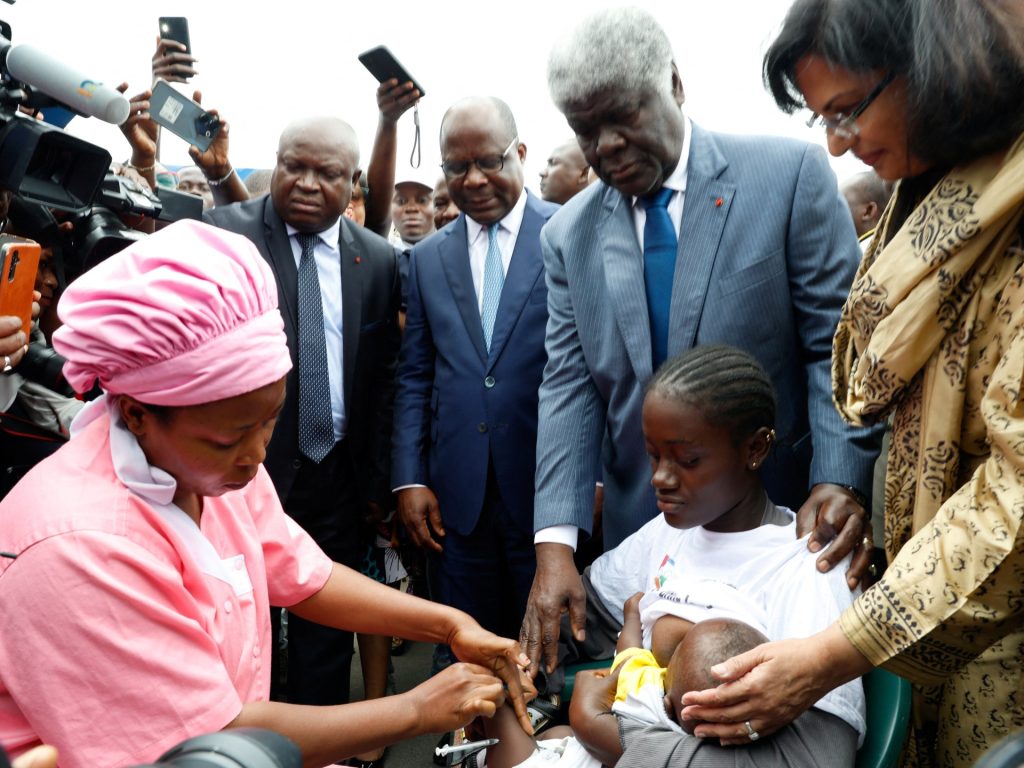Côte d’Ivoire launched a new vaccination drive across the country earlier this week after receiving the first doses of the malaria vaccine from the Serum Institute of India, the world’s largest vaccine manufacturer, in collaboration with Oxford University.
Malaria remains a major health problem in Côte d’Ivoire, with up to four people dying from the disease each day in the country of 28 million people. According to a 2022 World Health Organization (WHO) report, malaria causes more than 600,000 deaths annually worldwide, with 95% of cases occurring in Africa, and 80% of those occurring in children under the age of five.
A total of 656,600 doses of the new R21/Matrix M malaria vaccine have arrived in Côte d’Ivoire, where doctors will initially vaccinate 250,000 children aged between newborns and 23 months in 16 regions, according to the Ivorian government.
Professor Adrian Hill, director of the Jenner Institute at the University of Oxford in the UK and Lakshmi Mittal Professor of Vaccinology, told media on Monday that the effort was made possible through a joint initiative with the Serum Institute of India because of its “scale” and ability to mass-produce millions of vaccines at low cost.
Professor Hill said that after vaccinations begin in Côte d’Ivoire, the initiative will be expanded to other African countries, starting with Burkina Faso.
According to Gavi, an international health organization that works with the WHO and UNICEF, malaria vaccines are scheduled to be administered in 15 African countries in 2024. The countries plan to vaccinate about 6.6 million children with the malaria vaccine in 2024 and 2025.
Here’s what we know so far about the malaria vaccination campaign.
Which malaria vaccines are used?
Healthcare workers administer the R21/MatrixM malaria vaccine, the second malaria vaccine approved by the WHO in December last year, at a vaccination centre in Côte d’Ivoire.
Studies have shown that R21/MatrixM can reduce symptomatic malaria cases in the community by 75% within 12 months after three doses, with the effect persisting with the fourth dose one year later.
“Malaria kills more than 600,000 people each year, mainly among children, and the disease poses uniquely difficult scientific challenges. The complex makeup of the malaria parasite and a shape-shifting pathogen that has learned to evade our immune system make developing an effective vaccine a daunting challenge,” Professor Hill said in a statement last December.
“R21/Matrix-M is the culmination of 30 years of collaborative research and development in partnership with the Jenner Institute at the University of Oxford and, since 2017, the Serum Institute of India.”
The WHO and local health authorities are also distributing the vaccine. Mosquirix vaccine,alias RTS, S This year, more than 2.3 million children have been vaccinated against malaria across Africa.
The vaccine has been introduced primarily in Cameroon, Ghana, Kenya and Malawi, targeting children aged 5 months and older in areas with high P. falciparum endemicity.
How does the R21 vaccine work?
The R21 vaccine uses adjuvant technology to strengthen the immune response to the vaccine and protect against future infection with the disease.
The vaccine is designed to specifically target the sporozoite stage of the malaria parasite, the initial form of the parasite that enters the human body during a mosquito bite. By focusing on this stage, it boosts the immune system’s response and increases the effectiveness of malaria prevention. In addition, the vaccine can stop the parasite from infecting the liver and causing disease.
How widely available is the vaccine?
India’s Serum Institute, which has supplied more than 2 billion doses of COVID-19 vaccines worldwide, has the capacity to produce 100-200 million doses of the vaccine per year, making it more cost-effective and accessible. Professor Hill told Britain’s BBC Radio 4’s Today programme on Monday that the Serum Institute’s mass vaccine production capacity has reduced the cost of a single dose of R21/Matrix M from around $8-9 to around $4.
The vaccine will also be available in other African countries: “The new vaccine has been approved in Ghana, Nigeria, Burkina Faso and the Central African Republic, with shipments in the pipeline for a number of other countries,” Oxford University said in a statement to CNN.
How can we eradicate malaria?
The goal set by the WHO Global Malaria Programme (GMP) is to reduce malaria cases by 90 percent by 2030.
The steps being taken to achieve this include:
- Early detection and diagnosis of malaria infection prevents infection and death.
- Effective mass distribution of affordable vaccines in high-infection countries.
- The use of insecticide-treated bed nets (ITNs) and indoor residual spraying (IRS) reduces mosquito populations and infections caused by mosquito bites.
- In malaria-prone areas, we raise awareness about the disease, how it spreads and how it can be treated, and ensure adequate access to essential health facilities.
But challenges remain, according to the WHO report: “Countries, subregions and communities are at different points on the journey to malaria elimination and progress varies depending on levels of investment, biological determinants (related to patients, parasites and vectors), environmental factors, strength of health systems, and social, demographic, political and economic realities,” it said.


